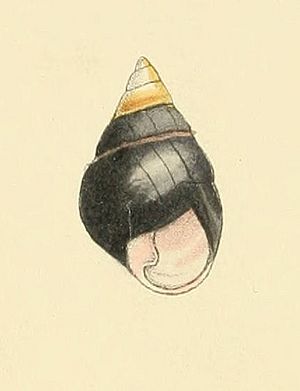Achatinella apexfulva facts for kids
Quick facts for kids Achatinella apexfulva |
|
|---|---|
 |
|
| Drawing of a shell of Achatinella apexfulva | |
| Conservation status | |
| Scientific classification | |
| Genus: |
Achatinella
|
| Species: |
apexfulva
|
| Synonyms | |
|
List
Achatinella lugubris Chemnitz
Achatinella pica Swainson Achatinella vespertina Baldwin Achatinella apicata var. alba Sykes Achatinella apicata Newcomb Achatinella swiftii Newcomb Achatinella aptycha Pfeiffer Helix Avex Fulva Dixon Turbo apexfulva Dixon, 1798 (original combination?) Turbo lugubris Chemnitz Monodonta seminigra Lamarck Bulimus seminiger Mke Apex gulickii Smith Apex lilaceus Gulick |
|
Achatinella apexfulva was a type of colorful, tropical land snail. It lived in trees and was once found on the island of Oahu, Hawaii. Sadly, this species is now believed to be extinct.
The name apexfulva means "yellow-tipped". This refers to the yellow color at the very top of the snail's shell. This snail was also the main example, or type species, for its group, the Achatinella genus.
About the Snail Family
The family of snails that Achatinella apexfulva belonged to is called Achatinellidae. This group shows amazing adaptive radiation. This means they started from one ancestor and changed over time into many different kinds of snails.
Scientists believe all tree snails in Hawaii came from a single snail ancestor. How that first snail traveled about 3,800 kilometers (2,360 miles) across the ocean is a mystery! One idea is that a bird carried a tiny ancestor snail to the islands. Birds have been known to carry other snail species. Another idea is that the snail floated across the ocean on a mat of plants or other debris. It might also have hopped from one island to another across the Pacific Ocean.
A. apexfulva was part of the Oahu group of snails. This group developed on Oahu island and includes most other snails in the Achatinella genus.
Where They Lived
This snail species lived only in the forests of Oahu island in Hawaii. It was found nowhere else in the world, which means it was endemic to Hawaii. However, it is now extinct.
Since 1981, Achatinella apexfulva was listed as an endangered species. A big reason for its decline was a predator called the rosy wolfsnail. This wolfsnail is from Central America. It was brought to Hawaii in the 1950s to control farm pests. But the rosy wolfsnail eats other snails and doesn't pick and choose its food. It has caused at least eight other snail species in Hawaii to go extinct.
Other problems for A. apexfulva included:
- Loss of its forest home due to trees being cut down.
- The introduction of rats, which also ate the snails.
- The arrival of the Jackson's chameleon, another predator.
The issues that A. apexfulva faced are not unique. Many snails in the Achatinellidae family are disappearing. It's estimated that between 75% and 90% of them are now extinct. The International Union for the Conservation of Nature last studied A. apexfulva in 1996. At that time, they listed it as Critically Endangered, meaning it was at very high risk of extinction.
George the Snail
In 1997, scientists gathered all the known A. apexfulva snails. They wanted to try and breed them in captivity because their numbers were dropping fast. Most of the baby snails born didn't survive. But one special snail did. This snail was named George. He was named after Lonesome George, a tortoise who was also the last of his kind.
By April 2011, George was the only remaining member of the Achatinella apexfulva species. Sadly, in January 2019, George died at 14 years old. His death meant that the species is now believed to be extinct.
What They Ate
Even though A. apexfulva lived on tree leaves, it didn't eat the leaves themselves. Its diet consisted of tiny bits of algae and mold that grew on the leaves.
See also
 In Spanish: Achatinella apexfulva para niños
In Spanish: Achatinella apexfulva para niños


